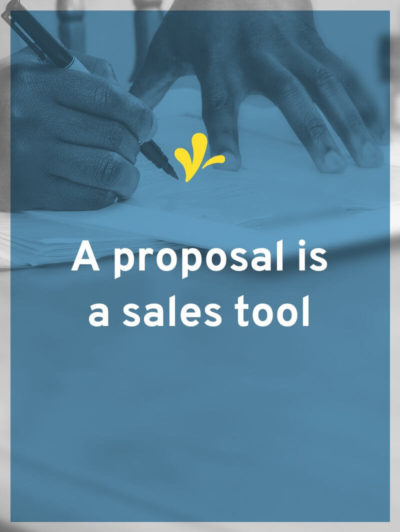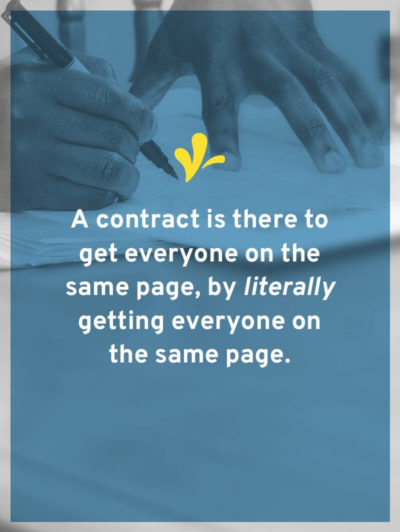Are you unsure if you should send your client a proposal or a contract? Contracts and proposals have very different purposes, so the secret to knowing which one you should send is figuring out why you are sending it.
By the end of this video and post, you’ll know:
- When you should send a proposal
- When you should send a contract
- The limited circumstances you can combine them into one document
Watch the short version | Read the long version
Watch
Video links
- Grab my book that helps you complete enough legal tasks to confidently launch (or grow) your business, knowing you have all your legal ducks in a row. (And the book includes a simple contract template!)
- Join us in the artist’s Courtyard and get instant access to the “How to write a contract” course
- Do you need to send a “formal” written contract? Watch why my answer is “nope!” here
- Join us in the artist’s Courtyard and get instant access to the “How to write a contract” course (or if you just want a client contract template, you can grab it here).
Does your business have a simple contract?

Inside my book, I include a simple contract template that you can use with those you work with. I also break down why legalese isn’t a requirement for a valid contract. The book also gives you a straightforward strategy to protect your ass(ets) without legal confusion. It’s the go-to guide you need to get all your legal ducks in a row.
(If you use the above Amazon affiliate link, I’ll make a small commission, but it doesn’t change the price you pay.)
Read
Do you waffle:
Should I send my client a contract? Or should I send them a proposal? Which one is right for this situation?
By the end, you’ll know exactly:
- when you should send a proposal
- when you should send a contract
- the limited circumstances you can combine them into one document
This week’s question comes to us from Mary in New York. Mary asks,
When should I send a proposal and when should I send a contract?
Contracts and proposals have different purposes
A contract and a proposal have two completely different purposes.
And understanding the purpose of what you’re sending and what stage you’re at in the relationship, is the secret to knowing which one you’re going to send.
The purpose of a proposal

It’s there to tell your client,
This is how I can solve your problem.
Your proposal should cover:
- you need this done
- this is how I can get where you want to be
- this is how much it’s going to cost you
A proposal is there to further the relationship because it’s primarily a sales tool.
Yes, your proposal might have some options. You could explain the high-touch service and the budget service.
In addition to having different price points, you might include a general workflow about how you see the project progressing.
But ultimately, the goal of a proposal is to get your potential client to say,
Yes, let’s work together.
Your proposal isn’t there to dive into the nitty-gritty about exactly what it looks like to work together. It isn’t there to explain how you can solve any problems that crop up.
Your proposal is there to open the door to having additional conversations about what it looks like to work together.
The purpose of a contract

A contract has a completely different purpose.
A contract is a relationship building tool.
A contract is there to get everyone on the same page, by literally getting everyone on the same page.
A contract is there to explain the roles and responsibilities.
It’s there to explain the nitty-gritty of the day-in and day-out process of working together.
I like to say that a contract is there to make sure that you’re not unintentionally disappointing your clients.
We’ve all worked with those clients who have completely unreasonable expectations about what you’re going to do for the cost.
And a contract assures that you and your client have similar understandings about:
- what the process looks like
- what you will do
- what you need from them (payment and otherwise)
That’s the purpose of your contract: to make sure everyone is on the same page about what the relationship is going to look like from a nitty-gritty standpoint.
A proposal is a 10,000-foot view, your contract has all of the trees in it.
When you might combine your proposal and contract
What are the limited circumstances where you might combine them?

The most common reason is situations like Frank the Freelancer.
Frank creates memorable first impressions online by doing brand and website design.
Frank only offers one package.
On his website, he describes his package. Frank’s package is that he designs a single website at a time and does the entire project, start to finish, in four weeks.
Which means his services page, kind of functions as a proposal. Because it explains:
- what his package includes
- how he works
- what the process looks like
Then on his services page, you can click the “Contact Me” button to tell Frank you are interested.
At that point, he schedules a 15-minute phone call with you to make sure that it’s a good fit and that you’ll enjoy working together. (And for Frank to make sure, you are at a point where you are ready for this kind of package.)
If you both agree, then Frank follows the call up with his combined “proposal and contract.”
This format works really well if you:
- only have a single offering
- “preclear” potential clients before sending the document over
My process to send proposals vs. contracts
Most of us aren’t like Frank.
So we’re going to send a proposal that outlines how the relationship will work.
Then we’ll ask our potential client to let us know if it sounds good.
And finally, send over the contract.
This proposal doesn’t have to be long and detailed.
In fact, for my law firm, they usually are just an email that bullets potential projects and the costs associated with each.
You don’t have to do something long and complicated.
You only need to convey important information and keep the conversation going.
Then once you’ve gotten on the same page about how you’re going to help your client and get them to their end goal, then you’ll send a contract.
And this contract will cover the nitty-gritty of what it looks like to work together.
How are you going to create your contract?
I’ve got four resources for you:
- a 4600+ word article that breaks down 17 sections that you might want to consider including in your contract
- a course, available exclusively in the artist’s Courtyard, designed to help you step-by-step create your contract and includes multiple contract templates (including a freelance and coaching contract!)
- a client contract template, want to cut right to the template? Then grab a copy of my client contract template that protects you (and those you work with) and includes information on how to customize the template for your business
- Grab my book that includes a simple contract template and helps you complete enough legal tasks to confidently launch (or grow) your business
Does your business have a simple contract?

Inside my book, I include a simple contract template that you can use with those you work with. I also break down why legalese isn’t a requirement for a valid contract. The book also gives you a straightforward strategy to protect your ass(ets) without legal confusion. It’s the go-to guide you need to get all your legal ducks in a row.
(If you use the above Amazon affiliate link, I’ll make a small commission, but it doesn’t change the price you pay.)
Do you still have questions?
No shame in that! One of the perks of membership in the artist’s Courtyard is a 24/7 private online community to ask your questions and get my answer (and insights from other creatives). Already a member? Ask your question! Not a member yet? Join us inside the artist’s Courtyard for $45/month!

Hi! I’m Kiff! I’m your friendly legal eagle (and licensed attorney).
My goal is to add ease to the legalese. And because I think basic legal resources should be available to every creative, I create a lot of free content.
If I’ve created something that has helped inject a little ease into your creative business and you would like to say “thank you”, you can make a contribution here.
If you’d like to hear more from me, I’d love to pop into your inbox every Friday morning to share additional ways to cut through the red tape and inject a little ease.
Get tips from your friendly legal eagle in your inbox…
Your privacy is important to us. Learn how we protect it here.

